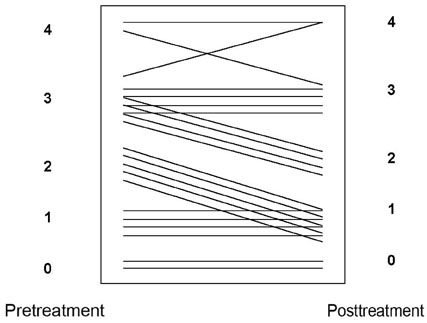Yonsei Med J.
2008 Aug;49(4):620-624. 10.3349/ymj.2008.49.4.620.
Second Line Palliative Endobronchial Radiotherapy with HDR Ir 192 in Recurrent Lung Carcinoma
- Affiliations
-
- 1Department of Radiation Oncology, Hacettepe University Faculty of Medicine, Ankara, Turkey. ugurselek@yahoo.com
- KMID: 1793198
- DOI: http://doi.org/10.3349/ymj.2008.49.4.620
Abstract
- PURPOSE
To observe the efficiency of reirradiation with high dose rate intraluminal brachytherapy in symptomatic palliation of recurrent endobronchial tumors. MATERIALS and METHODS: Between January 1994 and June 1998, 21 patients diagnosed with recurrent endobronchial tumors following external beam radiotherapy were treated palliatively with high dose rate intraluminal irradiation at Hacettepe University Oncology Institute. A single fraction of 10Gy was prescribed to the specified area in 9 patients and 15Gy to 12. RESULTS: Endobronchial treatment improved the performance and reduced symptomatology in 17 (81%) patients. Ten dyspneic patients (10/14, 71%) recovered clinically with an accompanying radiological downstaging. The median symptomatic palliation was 45 days (range, 0-9 months), and the overall median survival was 5.5 months (range, 4-12 months). The palliative intrabronchial brachytherapy was well tolerated, with the exception of in one patient with a fatal hemorrhage, and another with medically salvaged bronchospasm and intrabronchial edema. CONCLUSION: Recurrent patients with a history of previous thoracic external beam irradiation can be effectively palliated with high dose rate endobronchial reirradiation if the symptoms are directly related to the endobronchial tumor.
MeSH Terms
Figure
Reference
-
1. Jemal A, Thomas A, Murray T, Murray T, Thun M. Cancer statistics, 2002. CA Cancer J Clin. 2002. 52:23–47.
Article2. Eisert DR, Cox JD, Komaki R. Irradiation for bronchial carcinoma: reasons for failure. I. Analysis of local control as a function of dose, time, and fractionation. Cancer. 1976. 37:2665–2670.
Article3. Perez CA, Stanley K, Rubin P, Kramer S, Brady L, Perez-Tamayo R, et al. A prospective randomized study of various irradiation doses and fractionation schedules in the treatment of inoperable non-oat-cell carcinoma of the lung. Preliminary report by the Radiation Therapy Oncology Group. Cancer. 1980. 45:2744–2753.
Article4. Salazar OM, Rubin P, Brown JC, Feldstein ML, Keller BE. Predictors of radiation response in lung cancer. A clinico-pathobiological analysis. Cancer. 1976. 37:2636–2650.
Article5. Gauwitz M, Ellerbroek N, Komaki R, Putnam JB Jr, Ryan MB, DeCaro L, et al. High dose endobronchial irradiation in recurrent bronchogenic carcinoma. Int J Radiat Oncol Biol Phys. 1992. 23:397–400.
Article6. Seagren SL, Harrell JH, Horn RA. High dose rate intraluminal irradiation in recurrent endobronchial carcinoma. Chest. 1985. 88:810–814.
Article7. Speiser BL, Spratling L. Remote afterloading brachytherapy for the local control of endobronchial carcinoma. Int J Radiat Oncol Biol Phys. 1993. 25:579–587.8. Kaplan EL, Meier P. Nonparametric estimation from incomplete observations. J Am Stat Assoc. 1958. 53:457–481.
Article9. Macha HN, Koch K, Stadler M, Schumacher W, Krumhaar D. New technique for treating occlusive and stenosing tumours of the trachea and main bronchi: endobronchial irradiation by high dose iridium-192 combined with laser canalisation. Thorax. 1987. 42:511–515.10. Gaspar LE. Brachytherapy in lung cancer. J Surg Oncol. 1998. 67:60–70.
Article11. Gollins SW, Ryder WD, Burt PA, Barber PV, Stout R. Massive haemoptysis death and other morbidity associated with high dose rate intraluminal radiotherapy for carcinoma of the bronchus. Radiother Oncol. 1996. 39:105–116.
Article12. Bedwinek J, Petty A, Bruton C, Sofield J, Lee L. The use of high dose rate endobronchial brachytherapy to palliate symptomatic endobronchial recurrence of previously irradiated bronchogenic carcinoma. Int J Radiat Oncol Biol Phys. 1992. 22:23–30.
Article13. Nori D, Allison R, Kaplan B, Samala E, Osian A, Karbowitz S. High dose-rate intraluminal irradiation in bronchogenic carcinoma. Technique and results. Chest. 1993. 104:1006–1011.
Article14. Ornadel D, Duchesne G, Wall P, Ng A, Hetzel M. Defining the roles of high dose rate endobronchial brachytherapy and laser resection for recurrent bronchial malignancy. Lung Cancer. 1997. 16:203–213.15. Sawada S, Tanigawa N, Kobayashi M, Furui S, Ohta Y. Malignant tracheobronchial obstructive lesions: treatment with Gianturco expandable metallic stents. Radiology. 1993. 188:205–208.
Article16. Bolliger CT, Probst R, Tschopp K, Soler M, Perruchoud AP. Silicone stents in the management of inoperable tracheobronchial stenoses. Indications and limitations. Chest. 1993. 104:1653–1659.17. Vergnon JM, Costes F, Bayon MC, Emonot A. Efficacy of tracheal and bronchial stent placement on respiratory functional tests. Chest. 1995. 107:741–746.
Article18. Hetzel MR. Current use of lasers in pulmonary disease. World J Surg. 1983. 7:725–731.
Article19. Brutinel WM, Cortese DA, McDougall JC, Gillio RG, Bergstralh EJ. A two-year experience with the neodymium-YAG laser in endobronchial obstruction. Chest. 1987. 91:159–165.
Article
- Full Text Links
- Actions
-
Cited
- CITED
-
- Close
- Share
- Similar articles
-
- The Effects of High Dose Rate Brachytherapy in Recurrent Obstructive Bronchogenic Cancer after External Irradiation Therapy
- Development and Application of Ir-192 Brachytherapy Source in Korea
- Treatment outcomes of high-dose-rate intracavitary brachytherapy for cervical cancer: a comparison of Ir-192 versus Co-60 sources
- Endobronchial Brachytherapy for MalignantAirway Obstruction: Low Dose Rate Versus High Dose Rate
- Photodynamic Therapy for Endobronchial Obstruction due to Recurrent Lung Cancer : 2 Cases Report


